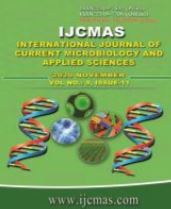


 National Academy of Agricultural Sciences (NAAS)
National Academy of Agricultural Sciences (NAAS)

|
PRINT ISSN : 2319-7692
Online ISSN : 2319-7706 Issues : 12 per year Publisher : Excellent Publishers Email : editorijcmas@gmail.com / submit@ijcmas.com Editor-in-chief: Dr.M.Prakash Index Copernicus ICV 2018: 95.39 NAAS RATING 2020: 5.38 |
The changes in temperature, microbial population dynamics and other factors were studied during the process of composting by layering residues of Calotropis procera, Prosopis juliflora, Azadirachta indica, Acacia nilotica and weeds in separate pits. Temperature began to rise soon after filling the residues and ranged between 55–59 °C for next 6 to 7 days with maximum being in Calotropis pit (59.2 °C). Estimation of microbial population dynamics and activity has shown that in the heat phase, fungal population remained low but reinfestation occurred after 30 days in all the composts except weed compost. There was a fluctuation in total actinomycetes and bacterial population in all the decomposing residues initially, however, at 150 days counts were maximum in Calotropis compost. Trichoderma harzianum disappeared during peak heating but reinfested occured at mature stage with maximum counts in P. juliflora compost, while Bacillus spp. was present throughout the composting period. At maturity, total fungi were maximum in neem followed by P. juliflora compost, but total actinomycetes and bacterial population was maximum in Calotropis compost. Maximum antagonistic actinomycetes (64.3 %) were estimated in A. nilotica compost. P. juliflora compost maintained its superiority in terms of microbial activity during the process of composting as well as at maturity. Among all the composts, maximum available micro-nutrients like Cu, Zn, Mn and Fe were estimated in compost prepared from A. nilotica.
 |
 |
 |
 |
 |